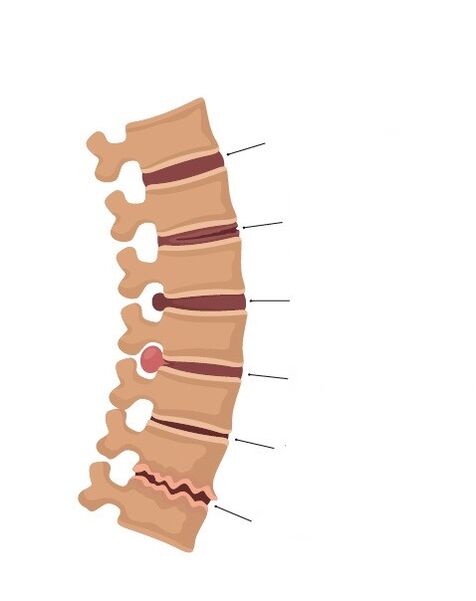The spine includes the cervical, thoracic, and lumbar sections and consists of 33-34 vertebrae located on top of each other and connected into a single chain.To evenly distribute the load on the spine during daily physical activity and when the body is in an upright position, the spine has physiological (normal) curves.Two forward convex curves in the cervical and lumbar regions (lordosis) and two posterior convex curves in the thoracic and sacral regions (kyphosis).Between the vertebrae there are intervertebral discs - cartilage, which has the function of absorbing shock and consists of a nucleus pulposus and a fibrous ring surrounding it.

Spinal chondrosis is a chronic disease characterized by the development of degenerative-dystrophic changes in the intervertebral discs with subsequent involvement of adjacent vertebrae and surrounding tissues in the process.
Nowadays, doctors often use the broader term “back disease” to refer to pain in the back and neck, sometimes replacing the term “osteoarthritis” with it.Back conditions include pain in the neck (cervical pain), neck and head (cervical pain), neck and shoulders (cervical pain), chest pain (chest pain), lower back pain (lumbodynia), lower back pain that radiates down the legs (lumbar pain).
Causes of spondylosis
To date, there is no exact data on the causes of degenerative changes in the spine.There are several theories that consider different factors: ingression (ingression - retrograde growth, retrograde movement), mechanical, immunological, hormonal, metabolic (metabolic), vascular, infectious, functional and genetic.The most popular is the association theory, according to which local (localized) premature aging of cartilage and bone occurs as a result of previous mechanical or inflammatory damage.According to this theory, the development of degenerative changes in the spine is genetically predetermined, and the appearance of the disease with corresponding clinical manifestations is due to the influence of many endogenous (internal) and exogenous (external) factors.
The likelihood of developing osteonecrosis increases with age, on the one hand due to overweight, sedentary lifestyle and poor physical fitness, and on the other hand due to heavy manual labor and exposure to vibration.
The load on the spine increases proportionally with the increase in body weight, so overweight people are overloaded even under conditions of moderate activity;The situation is aggravated by a tendency to be physically inactive due to poor tolerance to physical activity.
Psycho-emotional stress, along with a sedentary lifestyle, causes tension in individual muscle groups, changes in muscle tone and movement patterns - posture, gait.The development of scoliosis - lateral curvature of the spine, pathological kyphosis and scoliosis (exacerbation of physiological curves) also contribute to deformation of the intervertebral discs.
Disease classification

By localization:
- cervical spine degeneration;
- osteoarthritis of the thoracic spine;
- Osteoarthritis of the lumbar spine and sacrum.
According to the stage of the disease:
- exacerbation of the condition (maximum number of clinical manifestations);
- remission (no clinical manifestations).
Depending on which formation is pathologically affected, the affected structures of the spine are distinguished:
- Reflex syndrome - reflex tension of innervated muscles, or dystonia (muscle spasm), vascular, vegetative, dystrophic - develops when pain receptors are stimulated.
- Compression syndrome often develops against a protruding base (bulging, protrusion beyond the spine without affecting the integrity of the annulus fibrosus) or disc herniation due to compression of nerve roots, spinal cord or blood vessels (radiculopathy, neuropathy, myelopathy, ischemic syndrome are distinguished respectively).
Depending on the stage of development of the process, there are:
- Stage of the intradiscal pathological process (chondrosis).During this phase, intradiscal migration of the nucleus pulposus occurs.The nucleus pulposus penetrates its outer fibers through cracks in the annulus fibrosus.As a result, the nerve endings are irritated and pain occurs.
- The stage of instability or loss of fixation of the intervertebral disc is affected when the vertebra above is displaced relative to the vertebra below.During this period, instability syndrome, reflex syndrome, and even compression syndrome can form.
- The stage of formation of disc herniation is due to violation of the integrity of the annulus fibrosus, which can compress adjacent neurovascular systems, including spinal nerve roots.
- The stage of fibrosis of the intervertebral discs and the formation of marginal cartilage growth of the vertebral bodies, leads to immobility of the vertebrae and an increase in the area of their compensatory support on the defective intervertebral discs.In some cases, bony growths, like a herniated disc, can compress nearby nerve blood vessels.
Symptoms of osteoarthritis

Symptoms of osteonecrosis depend on the area of the spine damaged and the degree of changes that occur there, and the function of internal organs may be impaired.
Cervical spondylosis is characterized by pain in the neck that increases with movement, radiates down the arms and is accompanied by numbness in the fingers.
May complain of headaches in the occipital region, dizziness, ringing in the ears, dark circles or flashing spots before the eyes.
When the thoracic spine is affected, the patient may feel pain in the heart area, interscapular area, lasting, aching or pressing, often aching, like a stabbing, sharp knife.
They can occur or intensify when breathing deeply, when bending and turning, when raising arms, sneezing, coughing.There may be a feeling of numbness in the skin of the chest, abdomen and back.
When suffering from lumbosacral osteoarthritis, patients notice stiffness when moving, pain in the lower back, which can spread to one or both legs, and intensifies when bending, turning, walking, or lifting heavy objects.
Vegetative disorders may occur: cold feet at a comfortable temperature for the rest of the body, pale skin of the feet.There is a feeling of numbness and paresthesia (pins and needles sensation) in the skin of the legs and buttocks.
Diagnosis of disease
Instrumental diagnosis includes radiographs of the spine to rule out trauma, congenital structural defects, and determine bone development.The study was also carried out with functional tests - imaging during flexion and extension in the cervical and lumbar regions to exclude pathological displacement of the vertebrae relative to each other.
























